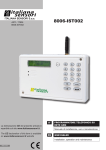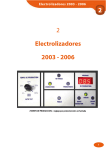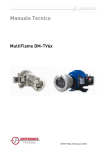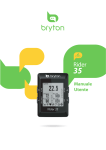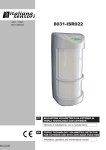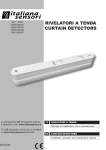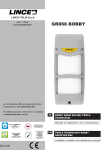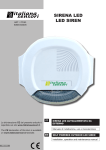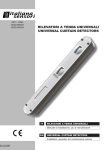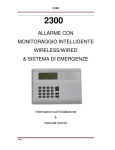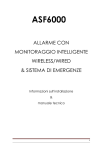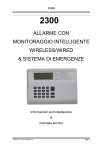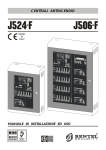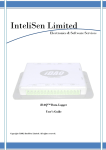Download File istruzioni - Italiana Sensori Presenta
Transcript
8014-ISR010 8072-ISR054 ART. / ITEM: 8014-ISR010 8072-ISR054 IT RIVELATORE DA INTERNO IN DOPPIA TECNOLOGIA VIA RADIO Manuale di installazione, uso e manutenzione EN DUAL TECHNOLOGY WIRELESS DETECTOR FOR INDOOR USE Installation, operation and maintenance manual MADE IN ITALY ITALIANA SENSORI S.A.s - Istruzioni originali - - Translation of the original instructions (original instructions in Italian) - INDICE CONTENTS 1. CARATTERISTICEH GENERALI....................................................................... 2 2. CARATTERISTICHE TECNICHE....................................................................... 3 3.AVVERTENZE.................................................................................................... 3 4. IDENTIFICAZIONE DELLE PARTI.................................................................... 3 5.INSTALLAZIONE............................................................................................... 4 5.1 CON SNODO.......................................................................................... 4 5.2 SENZA SNODO...................................................................................... 4 6. MEMORIZZAZIONE ......................................................................................... 5 7. FUNZIONE TEST............................................................................................... 5 8.SUPERVISIONE................................................................................................. 5 9. INIBIZIONE......................................................................................................... 6 10. GRAFICO DI COPERTURA............................................................................... 6 11. MANUTENZIONE E VERIFICHE PERIODICHE................................................ 7 11.1 PULIZIA ESTERNA DEL RILEVATORE.................................................. 7 12. SMALTIMENTO E ROTTAMAZIONE................................................................. 7 12.1DISINSTALLAZIONE............................................................................... 7 1. GENERAL FEATURES...................................................................................... 2 2. TECHNICAL FEATURES................................................................................... 3 3.NOTICES ........................................................................................................... 3 4. PARTS IDENTIFICATION................................................................................... 3 5.INSTALLATION.................................................................................................. 4 5.1 WITH BRACKET..................................................................................... 4 5.2 WITHOUT BRACKET.............................................................................. 4 6.STORAGE.......................................................................................................... 5 7. TEST FUNCTION............................................................................................... 5 8.MONITORING..................................................................................................... 5 9. STADN-BY MODE.............................................................................................. 6 10. COVERED AREA PATTERN.............................................................................. 6 11. MAINTENANCE AND PERIODIC CHECKS...................................................... 7 11.1 CLEANING THE EXTERNAL PART OF THE DETECTOR..................... 7 12. DISPOSAL AND SCRAPPING........................................................................... 7 12.1DISMANTLING........................................................................................ 7 Le informazioni riportate in questo manuale sono state compilate con cura, tuttavia Italiana Sensori non può essere ritenuta responsabile per eventuali errori e/o omissioni. Italiana Sensori si riserva il diritto di apportare in ogni momento, e senza preavviso, miglioramenti e/o modifiche ai prodotti descritti nel presente manuale. Italiana Sensori pone particolare attenzione al rispetto dell’ambiente. Tutti i prodotti ed i processi produttivi sono progettati con criteri di eco-compatibilità. Il presente articolo è stato prodotto in Italia. The informations in this manual have been issued with care, anyway Italiana Sensori will not be responsible for any errors or omissions. Italiana Sensori reserves the rights to improve or modify the products described in this manual at any times and without advance notice. Italiana Sensori pays particular attention to environment respect. Each product and each process have been designed with ecocompatibility criteria. This product has been made in Italy. 1. CARATTERISTICHE GENERALI 1. GENERAL FEATURES • • • • • • • • • • • • • Doppia trasmissione dell’evento “DTE”; Funzionamento in abbinamento al ricevitore universale 8012-ISA001 Basso consumo di corrente, alimentazione con batteria al litio; Circuito di rilevazione batteria scarica; Sensore dual PIR + microonda a 10,525 GHz; Lente di Fresnel anti UV; Funzione TEST della durata di 4 minuti durante i quali il rilevatore effettua una trasmissione ad ogni rilevazione senza andare in inibizione; Microinterruttore antisabotaggio a protezione del coperchio con lente; Tre tipi di trasmissione radio: ALLARME, SABOTAGGIO E BATTERIA SCARICA; Codice digitale a 72 bit. 2. CARATTERISTICHE TECNICHE 8014-ISR010 • • • 2. TECHNICAL FEATURES 8014-ISR010 8072-ISR054 8072-ISR054 Batteria al litio AA 3,6 V (codice 001510/00206AA) Power supply AA Lithium battery 3,6 V (item: 001510/00206AA) Corrente nominale 13 uA Rated current 13 uA Corrente massima 25 mA Maximum current Alimentazione Frequenza MW 10,525 GHz MW frequency Frequenza TX 868,3 MHz TX frequency Portata Radio (aria libera) 100 m Wireless range (free air) Portata di rilevazione 12 m Detection range Copertura orizzontale Temperatura di eserzio Peso (solo rilevatore) 2 • • • • • “DTE” Double Transmission of Event Working in conjunction with the universal receiver 8012ISA001 Low power consumption, powered by lithium battery; Low battery detection circuit; Dual PIR sensor + Microwave at 10.525 GHz; Fresnel lens, anti UV; TEST function lasting 4 minutes during which the detector makes a transmission for every detection without going inhibition; Anti-tamper micro-switch to protect cover with lens; Three types of wireless transmissions: ALARM, TAMPER AND LOW BATTERY; 72-bit digital code. 90° 6° Horizontal coverage 25 mA 10,525 GHz 868,3 MHz 100 m 12 m 90° 6° 5°÷ 40°C Operating temperature 5°÷ 40°C 110 g Weight (only detector) 110 g ITALIANA SENSORI S.A.s 3.AVVERTENZE • • • • • E’ buona norma prima di installare il rilevatore fare un’attenta valutazione dell’area da proteggere evitando zone cieche nell’area di rilevazione (mobili, scaffalature, etc…). Evitare che oggetti in movimento invadano l’area da proteggere (tende finestre, etc…). Evitare la presenza di animali nell’area protetta. Installare il rilevatore su un supporto stabile e privo di vibrazioni. Non installare il sensore all’esterno. 4. IDENTIFICAZIONE DELLE PARTI Part. 3.NOTICES • • • • • It is good practice to carefully assess the area to be protected before installing the detector, avoiding any blind spots in the area surveyed (furniture, shelves, etc ...). Prevent moving objects from invading the area to be protected (curtains windows, etc ...). Prevent animals from entering the protected area. Install the detector on a stable and vibration free support. Do not install the sensor outside. 4. PARTS IDENTIFICATION Identificazione Ref. Identification A Gambo dello snodo A Bracket arm B Collare in alluminio B Aluminum collar C Viti M3 per fissaggio snodo C M3 bracket mounting screws D Fondo del rilevatore D Detector base E Scheda elettronica E Electronic board F Microinterruttore antiapertura F Anti-tamper micro-switch G Trimmer regolazione sensibilità della microonda G Microwave sensitivity adjustment Trimmer H Viti parker fissaggio scheda elettronica H Board mounting screws I Frontale con lente di Fresnel I Front panel with Fresnel lens A A D B G C I H F E Fig. 1 3 ITALIANA SENSORI S.A.s P P R N N P P Fig. 2 5.INSTALLAZIONE 5.INSTALLATION Per il montaggio a parete si consiglia un’altezza di installazione compresa tra 2,1 m e 2,3 m. Lo snodo del rilevatore permette installazioni a soffitto e/o ad altezze superiori a quelle consigliate; in questi casi occorre inclinare opportunamente il rilevatore per adattare al meglio il campo di copertura alle effettive necessità. For wall mounting the recommended height is between 2.1 m and 2.3 m. The detector bracket means that it can be installed on the ceiling and/or at heights above those recommended; in these cases the detector should be tilted in a suitable manner to adapt the field of coverage to actual needs. 5.1 5.1 • • • • • 5.2 • SENZA SNODO Aprire il rilevatore facendo leva sugli agganci elastici presenti sul frontale con lente; Svitare le due viti parker (I) ed asportare la scheda elettronica (E); Inserire il tappo copriforo (R) sulla parte posteriore del fondo del rilevatore; Per fissare il rilevatore, sfondare le predisposizioni (N) per montaggio a parete o (P) per montaggio ad angolo, utilizzando uno strumento appuntito (può essere sufficiente un cacciavite a croce); Collegare la batteria (vedi capitolo memorizzazione) e chiudere il rlevatore facendo attenzione che gli scatti automatici siano incastrati. CON SNODO Fissare il gambo dello snodo (fig. 1 A) sul muro o sul soffitto utilizzando il tassello in dotazione; • Aprire il rilevatore facendo leva sugli agganci elastici (H); • Svitare le due viti parker (I) ed asportare la scheda elettronica (E); • Inserire il gambo dello snodo (A) nel collare di alluminio (B), far aderire il tutto con la parte posteriore del fondo del rilevatore (D) quindi fissare a pacchetto i tre particolari, utilizzando le due viti metriche (C); • Orientare il rilevatore nella direzione che garantisca la copertura desiderata; • Terminato l’orientamento, bloccare il movimento dello snodo serrando le due viti (C); • Rimontare la scheda elettronica (E) fissandola con le viti parker (I); • Inserire la batteria (vedi capitolo relativo alla memorizzazione). 9. inibizone 4 • • • • • 5.2 • • • • • • • • • WITHOUT BRACKET Open the detector by levering the elastic hooks on the front panel with lens Remove the two screws (I) and take out the electronic board (E) Insert the plug cover (R) on the rear of the detector base To fix the detector, break through the points provided (N) for wall mounting or (P) for corner mounting, using a pointed tool (a Phillips screwdriver may be sufficient); Connect the battery (see chapter on Storage) and close the detector, making sure that the automatic snap-on elements are in place. WITH BRACKET Fasten the arm of the bracket (fig. 1 A) to the wall or ceiling using the plug provided Open the detector by levering the elastic hooks (H) Remove the two screws (I) and take out the electronic board (E) Insert the arm of the bracket (A) into the aluminum collar (B), ensure that everything adheres to the rear of the detector base (D) then secure the three parts in a pack, using the two metric screws (C). Turn the detector in the direction that ensures the desired coverage After adjusting the direction, block movement of the bracket by locking the two screws (C) Mount the electronic board (E) using the screws (I) Insert the battery (see the chapter on storage) Close the detector by inserting the cover with Fresnel lens ITALIANA SENSORI S.A.s 6. MEMORIZZAZIONE 6. STORAGE Per la procedura di memorizzazione, inserire la pila quando richiesto dal manuale della ricevente utilizzata. For the storage procedure, place the battery when required by manual of the uesed receiver. 7. FUNZIONE TEST 7. TEST FUNCTION Tale funzione è stata implementata per facilitare la configurazione del rilevatore. Si può attivare togliendo il coperchio (la successiva chiusura non provoca cambiamenti di stato); entro un minuto la funzione verrà attivata. In questa condizione i LED si attiveranno ed avranno il seguente significato: • LED Rosso: si accende ad ogni trasmissione radio sia essa un sabotaggio che una rilevazione di allarme • LED Giallo: si accende ogni qualvolta la microonda rileva un movimento • LED Verde: si accende ogni qualvolta il PIR rileva un movimento Dopo circa 4 minuti il rilevatore esce automaticamente dalla modalità test, i LED vengono disattivati e viene attivata la funzione di inibizione (vedi capitolo 8 in seguito). This function was implemented to facilitate configuration of the detector. This can be activated by removing the cover (closing it again will not cause any change in state); within one minute the function will be activated. In this condition, the LEDs will light up and will have the following meanings: NOTE: 1. i LED saranno attivi esclusivamente quando il rilevatore è in modalità test; 2. Al termine del test i LED saranno in modalità sempre spento, per riattivarli al fine di verificare il funzionamento del rilevatore, occorre aprire e richiudere la copertura con lente (apertura e chiusura dell’antisabotaggio). 3. Per provare la zona di copertura del rilevatore è importante che il sensore sia chiuso e con la copertura con lente di Fresnel inserita. 4. Una volta effettuate le prove di rilevazione e copertura radio il rilevatore è pronto per il funzionamento, al termine della fase di test il funzionamento del rielvatore potrà essere verificato in accordo con il sistema radio al quale è collegato. NOTE: 1. the LEDs will only light up when the detector is in test mode; 2. When the test is completed the LEDs will be in permanent off mode, to turn them on in order to check that the detector is working you must open and re-close the cover with lens (open and close anti-tampering device). 3. To test the detector coverage area it is important that the sensor be closed and the cover with Fresnel lens be inserted. 4. Once the detection and wireless range tests are completed the sensor is ready to operate. At the end of testing, operation of the detector can be checked according to the wireless system to which it is connected. 8. SUPERVISIONE 8. MONITORING La supervisione è utile per aumentare il livello di sicurezza dell’impianto; i rilevatori con tale funzione attivata inviano, ad intervalli regolari, un breve segnale di esistenza in vita alla ricevente. Di default la funzione di supervisione non è attiva sul rivelatore; per attivarla occorre effettuare una procedura durante la fase di “self-test” iniziale. Il lampeggio dei LED nel “self- test” iniziale avviene nel seguente modo (supervisione disattiva): • 1 lampeggio LED rosso, • 1 lampeggio LED verde, • 1 lampeggio LED giallo. Per attivare la supervisione premere velocemente tre volte il microswitch di antisabotaggio entro i 30 secondi di self- test iniziale (F – Fig 1) e verificare che i tre LED lampeggino nel seguente modo: • 2 lampeggi LED rosso, • 2 lampeggi LED verde, • 2 lampeggi LED giallo. Per disattivare la supervisione, eseguire la stessa azione utilizzata per attivarla. Monitoring is usefull to improve the security system; the detectors with this function activated send, at regulars intevals, a short signal of “ existence in life” to the receveir. By default the monitoring function is not active on the detector; for activate the function is necessary follow a sequence during the power-on self-test phase. The LEDs flashing during the power-on self-test takes place in the following way (monitoring disabled): • 1 flash of the red LED, • 1 flash of the green LED, • 1 fash of the yellow LED. NOTE: 1. Le impostazioni della supervisione rimangono memorizzate anche se la pila viene rimossa. 2. per verificare lo stato della funzione servirsi delle segnalazioni dei LED durante la fase di self-test. 3. per attivare la fase di self-test, successivamente alla prima attivazione del rilevatore, togliere la pila per qualche secondo e re-inserirla. 4. é necessario attivare la supervisione sulla ricevente facendo riferimento al relativo manuale. NOTES: 1. The monitoring settings are kept in the device memory even in case of battery removal. 2. To verify if the function status, use the LEDs signals of the power-on self test. 3. To activate again the self-test after the first activation of the device, remove the battery for a few seconds and insert it again. 4. It is mandatory to activate the monitoring function referring to the product manual. • Red LED: lights up with each wireless transmission, whether it involve tampering or alarm detection. • Yellow LED: lights up each time the microwave detects a movement • Green LED: lights up each time the PIR detects a movement After about 4 minutes the detector will automatically exit the test mode, the LEDs are turned off and stand-by mode is activated (see chapter 8 below). To activate the monitoring function press quickly three times the tamper during the 30 seconds of power-on self-test (F- Fig. 1) and verify that the three LEDs flashing as follow: • 2 flashes of the red LED, • 2 flashes of the green LED, • 2 flashes of the yellow LED. For disabling the monitoring function, carry out the same action used for activate it. 5 ITALIANA SENSORI S.A.s 9 INIBIZIONE 9 STAND-BY MODE Nel funzionamento normale (LED spenti) il rilevatore attiva automaticamente la funzione INIBIZIONE per risparmiare batteria, questo comporta che, se l’ambiente è frequentato, il rilevatore rimanga inibito fino a quando non sussisteranno almeno 3 minuti di quiete (nessuna rilevazione). Questa importante funzione evita che il rilevatore trasmetta di continuo situazioni di allarme ad ogni passaggio di persone. Per verificare il funzionamento del rilevatore quindi occorre attendere almeno tre minuti senza alcuna rilevazione. In normal operating mode (LEDs off) the detector automatically switches to STAND-BY to save on battery, this means that, if the area is in use, the sensor will remain in stand-by mode until there is at least 3 minutes of quiet (no detection). This important feature ensures that the detector does not send out a continuous alarm each time a person passes. To test the detector it is therefore necessary to wait at least three minutes without any movement being detected. 10. GRAFICO DI COPERTURA 10. COVERED AREA PATTERN 8014-ISR010 8072-ISR054 VISTA IN PIANTA / PLAN VIEW VISTA LATERALE / SIDE VIEW Fig. 3 6 ITALIANA SENSORI S.A.s 11.MANUTENZIONE E VERIFICHE PERIODICHE 11. MAINTENANCE CHECKS 11.1 PULIZIA ESTERNA DEL RILEVATORE 11.1 CLEANING THE EXTERNAL PART OF THE DETECTOR Per assicurare il corretto funzionamento del rilevatore è necessario che la lente venga mantenuta pulita. Una lente non perfettamente pulita può causare problemi di rivelazioni e/o problemi alla funzione antimask. AND PERIODIC Keep the lens clean to guarantee proper operation of the detector. A lens which is not perfectly clean may cause detection problems and/or problems to the anti-mask function. Periodicità: quando necessario o in condizione di sporcizia evidente. Materiale da utilizzare: panno - acqua senza additivi. Procedura di pulizia: Frequency: when necessary or when clearly dirty. Material to be used: cloth - water with no additives. Cleaning procedure: IMPORTANT! Do NOT use chlorine-based or abrasive products or alcohol to remove particularly noticeable dirt. ATTENZIONE! Per rimuovere sporcizie particolarmente evidenti NON utilizzare prodotti a base di cloro, prodotti abrasivi oppure alcool. 1.Pulire il coperchio e la lente con un panno inumidito con acqua. 2. Ripassare con un panno asciutto. 1. Clean the lid and the lens with a cloth dampened with water. 2. 2. Wipe with a dry cloth. 12.SMALTIMENTO E ROTTAMAZIONE 12.DISPOSAL AND SCRAPPING 12.1DISINSTALLAZIONE 12.1DISMANTLING ATTENZIONE! Non disperdere nell’ambiente i componenti ed ogni altro materiale del prodotto. Rivolgersi a consorzi abilitati allo smaltimento ed al riciclaggio dei materiali. IMPORTANT! Do not dispose of the components or any other product material in the environment. Seek the assistance of companies authorised to dispose of and recycle waste materials. 1. Rimuovere il coperchio frontale 2. Rimuovere la pila. 3. Dividere le parti in base alla loro tipologia e smaltirle in accordo con le leggi vigenti. 1. Remove the front lid. 2. Disconnect the battery. 3.Divide the parts by type and dispose of them in accordance with applicable laws. 7 001530/00321SD Italiana Sensori S.a.s. Via Pordenone, 2 00100 Roma (RM) tel. +39 06 92928252 fax +39 06 92942586 [email protected] www.italianasensori.it








